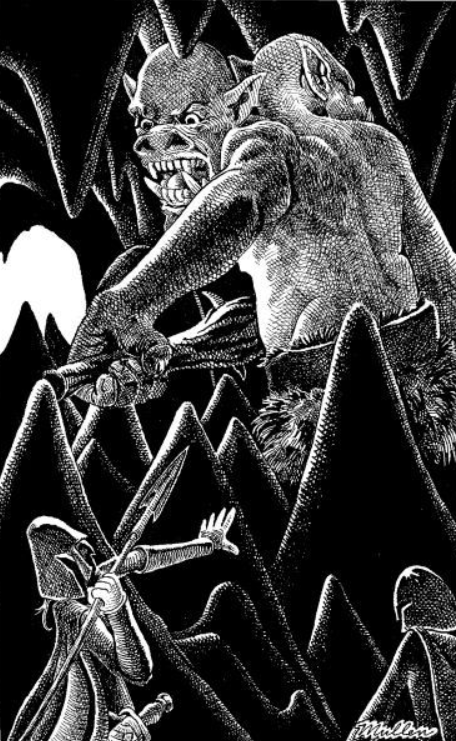Combat
Ordinary hand-to-hand combat is a messy, brutal affair. Hand-to-hand combat while lying facedown in mud far below the surface, where neither sun nor moon can reach is worse. It is a grisly, merciless, and often entirely desperate situation to find yourself in. Most avoid it at all costs.

Attacks
Players usually attack first in clockwise order around the GM, followed by the enemy's attacks.
Before each combat round, both sides roll a d6. Highest result side goes first. If the rolls are equal, both sides go at the same time.
If you choose to attack a target as your action in a Round of combat, take the dice noted on your weapon(s). Go through the following steps in order:
- Attackers declare targets and/or perform Shenanigans.
- All combatants attacking the same target roll their dice at the same time.
- Take the highest damage from any attacker.
- Subtract the target's Armour score.
- The attack causes that much damage.
Ranged weapons (bows, slings, javelins, etc.) require a DEX Danger roll to deal damage. They cannot be used while the character is in Close range melee combat.
Attacks that are Impaired, such as firing through cover, or fighting while grappled, roll d4 Damage regardless of weapon. Similarly, attacks that are Enhanced by a risky Shenanigan or a helpless or vulnerable target, roll d12 Damage.
Hit Protection ("HP") and Damage
Hit Protection are your characters ability to take hits and remain uninjured. When a character takes damage, they lose that many HP. If there is no HP left, the character takes Critical Damage, and any surplus Damage is removed from STR. The character must pass a STR Danger Roll. If successful the character is still able to fight, if not take Critical Damage.
Scars
When damage to a PC reduces their HP to exactly 0, they are sometimes changed irrevocably. See the scars table.
Critical Damage
A character that takes a Critical Damage, they take the Injured Condition, and are unable to take any further action until tended by an ally and takes a Short Rest. If left for an hour (set a timer) without tending to by an ally, the character dies (roll up a new level 1 Delver or RP a hireling).
Ability Score Loss
- If STR is reduced to 0, you are close to death.
- If DEX is reduced to 0, you are paralyzed.
- If WIL is reduced to 0, you are left victim to the magical powers or lie catatonic.
Advanced Attacks
Weapon Training
If a character has weapon training in a weapon type, they may roll with one dice type higher than what it usually is. For example, a Fighter, being trained in all weapons, rolls with a d6 instead of a d4 for Light Weapons and a d12 instead of a d10 for Heavy Weapons.
Blast
Blast weapons cause Damage to all targets in an appropriate area, rolling separately for each. If in doubt as to how many targets are affected, roll the weapon's damage die.

Shenanigans
When a character makes an Attack, they may also attempt a Shenanigan. Shenanigans are tricksy actions that include disarming, pushing, blinding, stunning, tripping, climbing, restraining, or anything else the GM agrees is plausible and unsporting to your average Brit.
To make a Shenanigan, declare the action you wish to take to impede the opponent. Both combatants perform Versus Rolls.
On a success, the next attack (could be that of an ally) deals Enhanced (d12) damage; if not, the opponent may immediately make a free action against you!
Sneak Attack
Characters who were not readied for combat must perform a WIL Danger Roll and miss the first Round.
Ambushes and traps usually sneak attack opponents.
Reaction
When the group encounters another creature, the character initiating contact must pass a WIL roll to avoid an unfavourable first reaction. Some encounters are always hostile, or always friendly, but all have a potential to change after first contact.
Morale
When NPCs reach a breaking point during a battle, they must test their morale by rolling WIL. If failing, they rout or surrender. Fleeing to safety under pursuit requires a DEX roll and somewhere to redraw to.
Breaking points may include:
- after losing half their HP (if alone),
- after their first casualty,
- after half of their forces are lost,
- after their leader is killed,
- after they are attacked by something they fear.